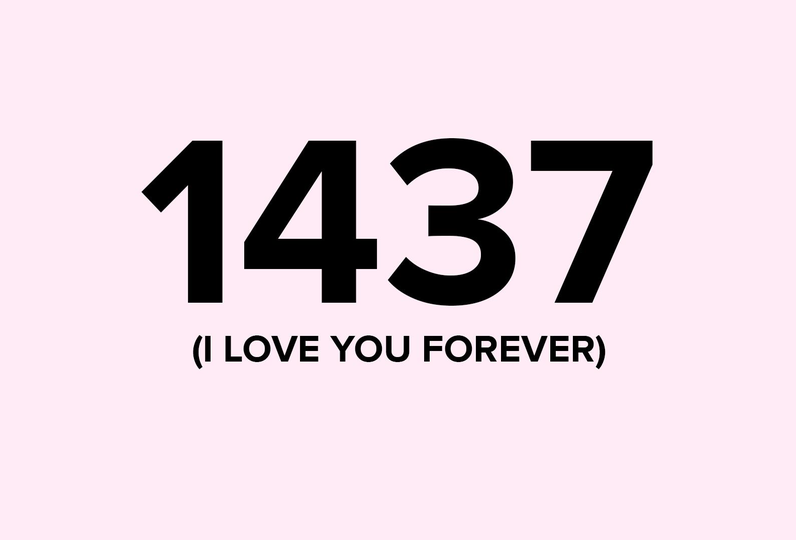Are you familiar with the number “1437” being used in digital communication, and are you curious about its significance? While some people might believe that this code holds hidden and secret meanings. Others argue that it’s merely a harmless trend among young people. In this article, we’ll delve into the 1437 meaning code and what it might indicate about modern communication practices. Join us as we explore the enigmatic world of digital slang and uncover the truth behind this mysterious code.
What is meant by “1437” on social media?

Image credit – new in Hindi
The term “1437” is a code or slang term used by some people to express love and affection. The digits in “1437” represent the number of letters in each word of the phrase. “I love you forever”. This code has become popular among some young people. As a way to express their feelings in a concise and secretive way.
The use of codes and slang terms in communication is not a new phenomenon. But with the rise of digital communication and messaging apps, it has become more prevalent. This is particularly true for younger generations who are more adept at using technology and social media platforms.
While 1437 meaning may seem harmless and endearing, parents should still be aware of their children’s online activities and communication. It’s important to establish an open and honest dialogue with your children about their online relationships and interactions. To encourage them to be cautious when communicating with strangers or sharing personal information online.
Additionally, parents should educate themselves on the different codes and slang terms. They are used in online communication to better understand their children’s conversations. By staying informed and involved, parents can help ensure their children’s safety and well-being in the digital age.
Is there any history behind “1437”?
The code “1437” is a contemporary creation used by some young people. To express feelings of love and affection in a concise and secretive manner. It appears to have no historical context or cultural significance.
As digital communication and messaging apps become more prevalent. Young people are increasingly using codes and slang terms to communicate more efficiently. This code reflects the changing trends in language and communication, particularly among those familiar with the technology.
While the 1437 meaning may be a modern creation. The concept of expressing love and affection in a concise and secretive way is not new. Throughout history, people have used various symbols, gestures. Also expressions to convey their emotions without saying too much.
It’s important for parents to stay aware of their children’s online activities and communication. To establish an open and honest dialogue about their online relationships. By educating themselves on the different codes and slang terms used in digital communication. Parents can better understand their children’s conversations and help ensure their safety and well-being.
Which generation of people mostly use it?
The “1437” code is predominantly used by young people, particularly teenagers and those in their early twenties. This is due to the fact that this code has gained popularity among individuals. For those who are comfortable with digital communication and messaging apps. Which are often more popular among younger generations.
However, it is worth noting that the use of codes. Or slang terms in communication are not restricted to a specific age group. People of all ages may use codes or abbreviations to communicate more efficiently. Express themselves in a concise and secretive way.
In any case, it is important for parents or guardians to be mindful of their children’s online activities and communication. Particularly if they are teenagers or young adults. Establishing a culture of open and honest communication about online relationships and interactions. These can help foster trust and promote safe online practices.
Are there any other codes like “1437”?
The use of codes and slang terms in digital communication is common among young people. “1437” is just one example of many. These codes and abbreviations serve as a means of conveying feelings or ideas in a brief and secretive way. They can be difficult for those who are unfamiliar with them to understand.
Some other popular codes used by young people include “ILY” (I love you), “WYD” (what are you doing). Also “RN” (right now), and “TBH” (to be honest), to name a few. These codes have become part of the modern lexicon. Especially among those who frequently use digital communication and messaging apps.
Parents and guardians should be mindful of the various codes and slang terms. That used in digital communication to better comprehend their children’s conversations and interactions. It’s also important to establish an environment of open and honest communication about online activities. Also relationships to ensure the safety and well-being of young people in the digital era.
Conclusion
To sum up, we’ve explained about 1437 meaning & the use of digital slang, such as the “1437” code, is prevalent among today’s youth. Although it may appear puzzling to those who are not acquainted with its meaning. It is essentially a harmless trend that enables individuals to express their emotions. Sentiments in a brief and secretive manner. As with any type of digital communication, it is critical for parents and caregivers to be aware of the different codes and slang terms employed by young people to better comprehend their conversations and interactions. By creating an environment of transparency and open dialogue regarding online activities and relationships. We can guarantee the safety and well-being of young people in today’s digital world.







